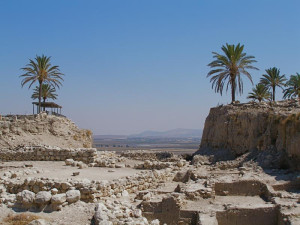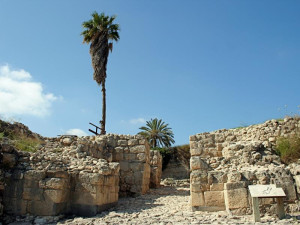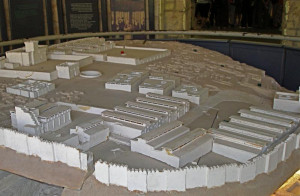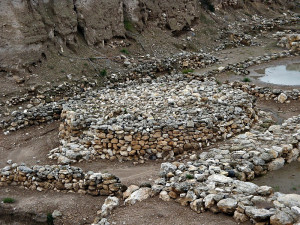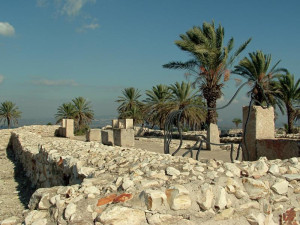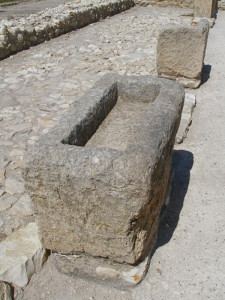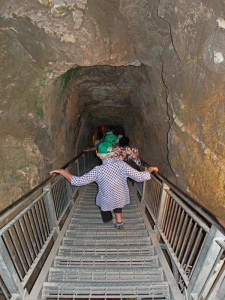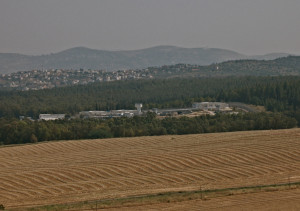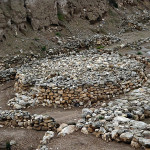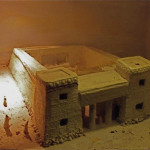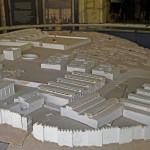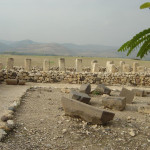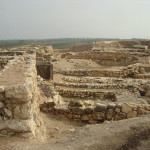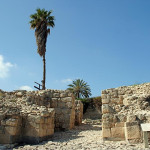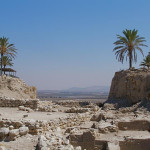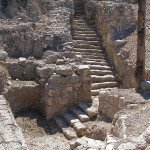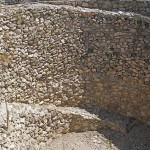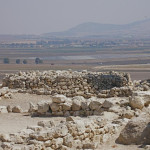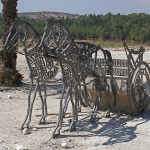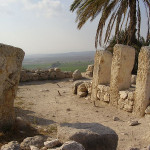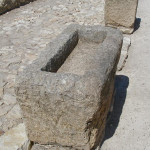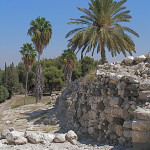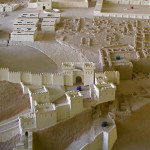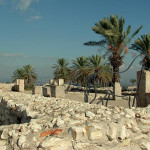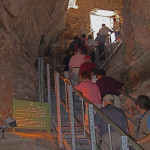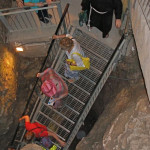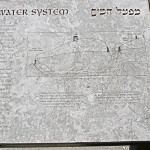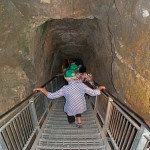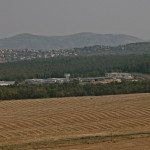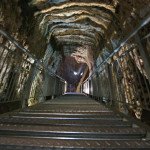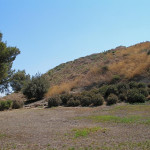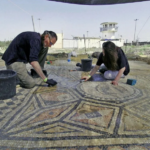Israel
Megiddo, named in the Book of Revelation as the setting for a future battle between the forces of good and evil, is for archaeologists perhaps the most important site in Israel dating from biblical times.
Its much-excavated tel, a mound rising 60 metres above its surroundings, has revealed the remains of at least 20 cities built one on top of the other.
The 6-hectare site has yielded temples, lavish palaces, massive fortifications, private houses, a grain silo and an elaborately-engineered water system.
Megiddo is 35 kilometres southeast of Haifa, at the southern end of the fertile Jezreel Valley. Destroyed and rebuilt many times during its turbulent history, it was occupied almost continuously from around 6000 BC until about 500 years before Jesus Christ was born.
From its strategic position, overlooking the key pass through the Carmel Mountains, it dominated the crossroads of ancient trade and military routes that linked Egypt with Mesopotamia and Asia Minor.
Armies of all the great generals who campaigned in the Middle East tramped across the plain of Jezreel, from the Egyptian pharaoh Thutmose III to General Edmund Allenby, including Alexander the Great and Napoleon. As Thutmose III claimed in the 15th century BC, “Capturing Megiddo is as good as capturing 1000 cities”.
In 2005 the remains of an ancient Christian prayer hall were uncovered in the grounds of a nearby prison. Dated to the middle of the 3rd century, this may be the oldest church discovered in Israel. A mosaic inscription with the words “God Jesus Christ” is one of the earliest ever found that mentions Jesus Christ.
Site of epic battles
Megiddo has been the site of epic and decisive battles down the ages. The Battle of Megiddo in the 15th century BC, when Egyptians under Thutmose III conquered Canaan, is the first reliably recorded battle in history.
Battles around Megiddo are mentioned in the Old Testament. The “king of Megiddo” was among those Joshua defeated after the Israelites entered Canaan in the 14th century BC (Joshua 12:21).
A century later the Israelite prophetess Deborah routed the Canaanites “by the waters of Megiddo” (Judges 5:19-21). Two kings of Judah, Ahaziah and Josiah, were battle casualties at Megiddo (2 Kings 9:27; 23:29-30).
In later times Greeks, Romans, Byzantines, Muslims, Crusaders, Mamlukes, Mongols, Persians, French, Ottomans, British, Germans, Arabs and Israelis all fought in this blood-soaked sector of the Holy Land.
The 1918 Battle of Megiddo, in which General Allenby led British, Indian, Australian and New Zealand troops against the Ottoman Turks, was decisive in the Allied conquest of Palestine. When Allenby was made a viscount, he took the title “Lord of Megiddo”.
Because Revelation 16:16 identifies Armageddon (from the ancient Greek Harmagedon, or Mountain of Megiddo) as the scene of an apocalyptic battle between good and evil, the name has become a dramatic byword for the end of the world.
According to an archaeology guide, K. Kris Hirst, “The archaeological site of Megiddo, known as Tell el-Mutesellim, has had more rubbish written about it in science fiction and horror movies and books than any other single archaeological site on the planet.”
But, contrary to the beliefs of fiction writers, Armageddon is not described as the final battle. The final encounter, at Jerusalem 1000 years later, is to be the battle against Gog and Magog. The ultimate triumph of good over evil, it will precede “the new Jerusalem, coming down out of heaven from God” (Revelation 20:7-10; 21:2).
Many archaeological remains to see
Visitors to the World Heritage Site of Megiddo have much to see, beginning with a model in the reception centre depicting the tel during the 10th-century BC reign of King Solomon — who used forced labour to fortify the city (1 Kings 9:15).
Other highlights along the path around the mound include:
• A flight of well-preserved stone steps from around the 7th century BC, leading from the city gates down to a plastered pool.
• The Canaanite city gate from 1550-1200 BC. Flanked by four chambers, it led to the palace complex of Megiddo’s rulers.
• A massive stone wall, 2 metres thick, marking the site of the Canaanite palace destroyed in the 12th century BC. A treasure trove of 382 carved ivory artifacts, including ornaments and combs, discovered in one of its rooms testifies to ancient Megiddo’s wealth and sophistication.
• Two elongated complexes often called Solomon’s stables, though now attributed to King Omri or King Ahab in the 9th century BC. Archaeologists also debate whether they were stables, some arguing they were too small for horses and were more likely storehouses, markets or even barracks for troops. Stone troughs indicate that horses were fed in the area.
• A “high place” with remains of several Canaanite temples and a circular altar of unhewn stones, 8 metres in diameter and 1.5 metres high, with seven steps leading to its top, where animal sacrifices took place. This sacred area, uncovered when archaeologists cut a deep channel through the tel prior to the First World War, was in use for 2000 years from about 3000 BC.
• A huge circular silo, dug 7 metres into the ground and 11 metres in diameter, capable of storing 1000 tons of grain. Two staircases around the sides lead to the bottom and a domed roof probably covered the structure, which dates from 700 BC.
Monumental project brought water into city
The most impressive construction at Megiddo is underground.
To ensure access to the spring at the bottom of the tel’s southwestern slope, engineers in the much-besieged city dug a 25-metre vertical shaft down to bedrock, then a 70-metre tunnel sloping up to the spring.
The tunnel was cut from both ends and the two gangs of workers had to make only a small correction before they met.
Then the outside entrance to the spring was sealed with a massive stone wall and concealed with earth so a besieging enemy could not discover it.
This monumental project was apparently undertaken during the reign of King Ahab, about 150 years before King Hezekiah quarried his water tunnel in Jerusalem.
When it was completed, residents standing at the top of the shaft could lower buckets to draw water without entering the tunnel or leaving the city.
Modern stairways — 187 steps down and 77 steps up — allow hardy visitors to view this engineering feat from the inside.
Unique inscription in ancient church
What may be the oldest church remains in Israel were also among the most inaccessible when they were discovered in 2005 — in the grounds of a military prison near Megiddo.
Work on detention cells to replace a prisoners’ tent encampment was under way when an inmate worker discovered ancient remains.
A prayer hall measuring about 10 metres by 5 metres was found in the southwest corner of a large building that also functioned as a Roman military administrative centre.
Believed to be from the middle of the 3rd century — before Christianity became the religion of the Roman Empire — it evidently served Christian soldiers in the two Roman legions based there, as well as the local Christian community.
In the superbly preserved mosaic floor, an inscription records that a woman named Akeptous offered the eucharistic table “to God Jesus Christ as a memorial”. No earlier inscription mentioning Jesus Christ has been found in the Holy Land.
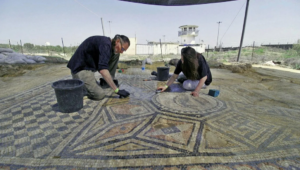
Cleaning and preparing the Megiddo mosaic for travel to the Museum of the Bible in the United States, with the Megiddo prison watchtower in the background (Emil Aladjem / Israel Antiquities Authority)
Other inscriptions name a Roman centurion, Gaianus, who paid for the mosaic floor; an artisan, Brutius, who made it; and four women — Primilla, Cyriaca, Dorothea and Chreste. Images of fish — an early Christian symbol — are also found.
The Israel Antiquities Authority has recommended moving the prison to a new location so the discoveries can be displayed. In the meantime, the church has been covered with dirt and tarpaulins.
In 2024 the mosaic was displayed at the Museum of the Bible in Washington, DC.
In Scripture:
Joshua defeats the king of Megiddo: Joshua 12:7,21
Deborah defeats Sisera’s Canaanites: Judges 5:19-20
Solomon fortifies Megiddo: 1 Kings 9:15
King Ahaziah dies at Megiddo: 2 Kings 9:27
Josiah killed at Megiddo: 2 Kings 23:29; 2 Chronicles 35:20-24
The battle of Harmagedon: Revelation 16-18
Administered by: Israel Nature and Parks Authority
Tel.: 972-4-6590316
Open: Apr–Sep 8am–5pm, Oct–Mar 8am–4pm (last entry one hour before closing time)
- Round altar in temple complex at Megiddo (Steve Peterson)
- Temple model at Megiddo (Seetheholyland.net)
- Model of Megiddo tel (Seetheholyland.net)
- Remains of an apparent storehouse at Megiddo (Biblicalisraeltours.com)
- View across the ruins of Megiddo (Biblicalisraeltours.com)
- Canaanite city gate from the 15th century BC (Golf Bravo / Wikimedia)
- Temple complex, with plain of Jezreel seen through archaeologists’ trench (Seetheholyland.net)
- Staircase descending from a city gate to a plastered pool at Megiddo (Seetheholyland.net)
- Silo for storing grain at Megiddo (Seetheholyland.net)
- Round altar in temple complex at Megiddo (Seetheholyland.net)
- Megiddo artwork of two-horse chariot (Seetheholyland.net)
- Columns from an apparent storehouse at Megiddo (Avishai Teicher)
- Stone trough from the 9th century BC (Seetheholyland.net)
- Field-stone construction of a wall at Megiddo (Seetheholyland.net)
- City gate in Megiddo model (Seetheholyland.net)
- Remains of what may have been stables (Hanay / Wikimedia)
- Visitors leaving Megiddo’s water system (Yair Talmor)
- Visitors entering the water tunnel at Megiddo (Seetheholyland.net)
- Cross-section of Megiddo’s water system (Seetheholyland.net)
- Descent into the Megiddo water tunnel (Seetheholyland.net)
- Megiddo prison where ancient church was found (James Emery)
- Looking up stairs in the Megiddo water system (James Emery)
- Slope of tel formed by successive destroyed cities (Seetheholyland.net)
- Cleaning and preparing the Megiddo mosaic for travel to the Museum of the Bible in the United States, with the Megiddo prison watchtower in the background (Emil Aladjem / Israel Antiquities Authority)
References
Bourbon, Fabio, and Lavagno, Enrico: The Holy Land Archaeological Guide to Israel, Sinai and Jordan (White Star, 2009)
Bowker, John: The Complete Bible Handbook (Dorling Kindersley, 1998)
Brownrigg, Ronald: Come, See the Place: A Pilgrim Guide to the Holy Land (Hodder and Stoughton, 1985)
Charlesworth, James H.: The Millennium Guide for Pilgrims to the Holy Land (BIBAL Press, 2000)
Finkelstein, Israel, and Ussishkin, David: “Back to Megiddo” (Biblical Archaeology Review, January/February 1994)
Freeman-Grenville, G. S. P.: The Holy Land: A Pilgrim’s Guide to Israel, Jordan and the Sinai (Continuum Publishing, 1996)
Gonen, Rivka: Biblical Holy Places: An illustrated guide (Collier Macmillan, 1987)
Kochav, Sarah: Israel: A Journey Through the Art and History of the Holy Land (Steimatzky, 2008)
Metzger, Bruce M., and Coogan, Michael D.: The Oxford Companion to the Bible (Oxford University Press, 1993)
Murphy-O’Connor, Jerome: The Holy Land: An Oxford Archaeological Guide from Earliest Times to 1700 (Oxford University Press, 2005)
Samet, Inbal: Megiddo National Park (Israel Nature and Parks Authority leaflet)
Tzaferis, Vassilios. “Inscribed ‘To God Jesus Christ’ ” (Biblical Archaeology Review, March/April 2007)
Wareham, Norman, and Gill, Jill: Every Pilgrim’s Guide to the Holy Land (Canterbury Press, 1996)
External links
The Megiddo Expedition (Tel Aviv University)
Tell Megiddo (BibleWalks)
Tel Megiddo (Wikipedia)
Megiddo — the Solomonic Chariot City (Israel Ministry of Foreign Affairs)

